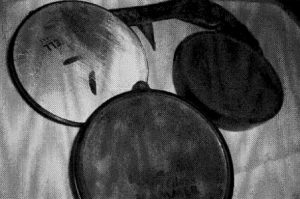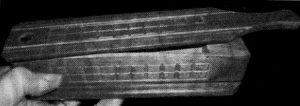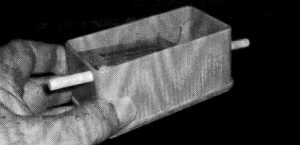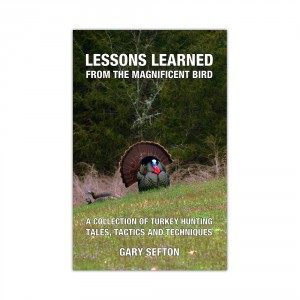Gary Sefton: “When I want to sound just like a turkey, I use a friction call.”
No matter if you are just learning how to turkey hunt or you are a seasoned professional, you should have a good working relationship with friction turkey calls. I can call well enough to fool a turkey on just about any calling device, but when I want to sound just like a turkey, I use a friction call. They are accurate. They are easy to use. They are tried and true. And they have been around for a long time.
 Not long after the first pterodactyl learned to gobble and evolved into a turkey, primitive men developed a taste for turkey breasts and evolved into turkey hunters. It didn’t take primitive men long to figure out the advantage of being able to attract turkeys close enough to inflict a mortal wound with a thrown rock. When a caveman was attacked by a lovesick gobbler as he tried to scratch some graffiti on a rock wall with a sharp stick an idea sparked in his prehistoric brain and friction turkey calls were born out of coincidence and necessity. Or something like that. I’m not sure how it started, but friction turkey calls have been around a long time.
Not long after the first pterodactyl learned to gobble and evolved into a turkey, primitive men developed a taste for turkey breasts and evolved into turkey hunters. It didn’t take primitive men long to figure out the advantage of being able to attract turkeys close enough to inflict a mortal wound with a thrown rock. When a caveman was attacked by a lovesick gobbler as he tried to scratch some graffiti on a rock wall with a sharp stick an idea sparked in his prehistoric brain and friction turkey calls were born out of coincidence and necessity. Or something like that. I’m not sure how it started, but friction turkey calls have been around a long time.
 A friction turkey call is characterized as any device that involves rubbing two different surfaces together to create a sound. A vast array of implements and devices fall into this category, including scratch boxes, hinged lid boxes, push-pin boxes, slate and peg, glass and peg, aluminum, carbon, and any combination of the aforementioned, and on and on.
A friction turkey call is characterized as any device that involves rubbing two different surfaces together to create a sound. A vast array of implements and devices fall into this category, including scratch boxes, hinged lid boxes, push-pin boxes, slate and peg, glass and peg, aluminum, carbon, and any combination of the aforementioned, and on and on.
Every one of these devices has been pondered on and pounded on and prayed over and perspired on for one ultimate purpose — to sound like a turkey. More precisely, a hen turkey, a yelping hen turkey. The turkey sound is built into the call. If you scratch it right or push the right button or slide the lid, you will sound just like a turkey. Even the sorriest of the lot will do a decent job of it. Some of the old calls have yet to be improved on while some of the newer models which blend computer technology with space-age materials are simply amazing.
 And friction calls are easy to use. You can be tone-deaf, with no sense of rhythm and post-nasal drip and call turkeys with a box or slate call. A little dexterity won’t do any harm, but it isn’t necessary. Anyone can call turkeys with almost any one of the friction devices, the main reason being you only have to learn to make one sound — the yelp. And most friction calls make yelps to perfection with a minimum of technique and effort. Most turkeys that are called in using cutts and cackles and clucks and purrs could have just as easily been called with yelps.
And friction calls are easy to use. You can be tone-deaf, with no sense of rhythm and post-nasal drip and call turkeys with a box or slate call. A little dexterity won’t do any harm, but it isn’t necessary. Anyone can call turkeys with almost any one of the friction devices, the main reason being you only have to learn to make one sound — the yelp. And most friction calls make yelps to perfection with a minimum of technique and effort. Most turkeys that are called in using cutts and cackles and clucks and purrs could have just as easily been called with yelps.
This is not to say friction calls are limited to yelps, they also make great clucks and purrs. In fact, I think a good slate or glass call is the most versatile calla available when accuracy is part of the equation.
Now I’ll take it one step further and tell you how to operate some of these wonderful friction calls. We know that hen yelps are two-note sounds. Most friction calls are designed specifically to produce the high-pitched “kee” sound then break over into the lower-pitched “youk” sound. Put the two sounds together and they make up the classic yelp.
Friction calls employ increased pressure or different angles of contact to produce the “kee” sound as the pressure is decreased or the angle is changed, the “youk” kicks in.
 The push-button or push-pull call has to be the easiest of the lot. This nifty little call illustrates the mechanics of friction calling and you should be able to master if with no trouble. One of the most clever turkey calling devices on the market, if you can fog up a mirror you can yelp on a push-button call. You just push the button. How hard is that? There are a lot of push-button calls on the market. Try them out and choose the one that sounds like a turkey to you. The good ones sound exactly like a turkey.
The push-button or push-pull call has to be the easiest of the lot. This nifty little call illustrates the mechanics of friction calling and you should be able to master if with no trouble. One of the most clever turkey calling devices on the market, if you can fog up a mirror you can yelp on a push-button call. You just push the button. How hard is that? There are a lot of push-button calls on the market. Try them out and choose the one that sounds like a turkey to you. The good ones sound exactly like a turkey.
Since push-button calls are so easy to use, if you continue to use them after your first year of turkey hunting you will be considered a bottom-feeding wimp and a tourist by your hunting buddies.
LESSONS LEARNED FROM THE MAGNIFICENT BIRD, by Gary Sefton
Gary Sefton is an expert caller of turkeys and has been so for a long time. He judged the Grand National Turkey Calling Contest more than 12 years, plus the U.S. Open turkey calling contest and the NRA’s $50,000 “Great American Game Calling Challenge” twice. He holds several state and national titles in friction and open turkey calling contests.
He has given turkey calling and hunting seminars, throughout the U.S. for a couple of decades and written articles for Turkey & Turkey Hunting and Turkey Call magazines and other regional and national outdoor publications. He has appeared on nationally syndicated radio and television outdoor shows and is featured on several DVDs.
An award-winning songwriter, he also composed and performed the “Magnificent Bird” CD, the classic musical tribute to the wild turkey.
Chapters: Turkey Talk, What to Say, How to Say It, the Patience Factor, Locating Birds, Use Your Head, When Gobblers Get Lockjaw, Shooting, Decoys & Blinds, Fall Turkey Hunting, Bowhunting, Problem Turkeys, Turkey Hunting Weather, Unusual Problems, the Right Way to Cook a Wild Turkey.
The book is paperback, 5-1/2″ x 8-1/2″, 201 pages. It can be ordered here on this website.


